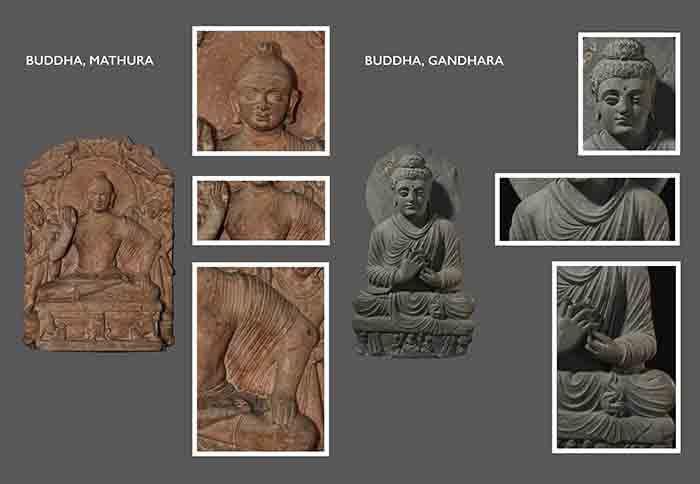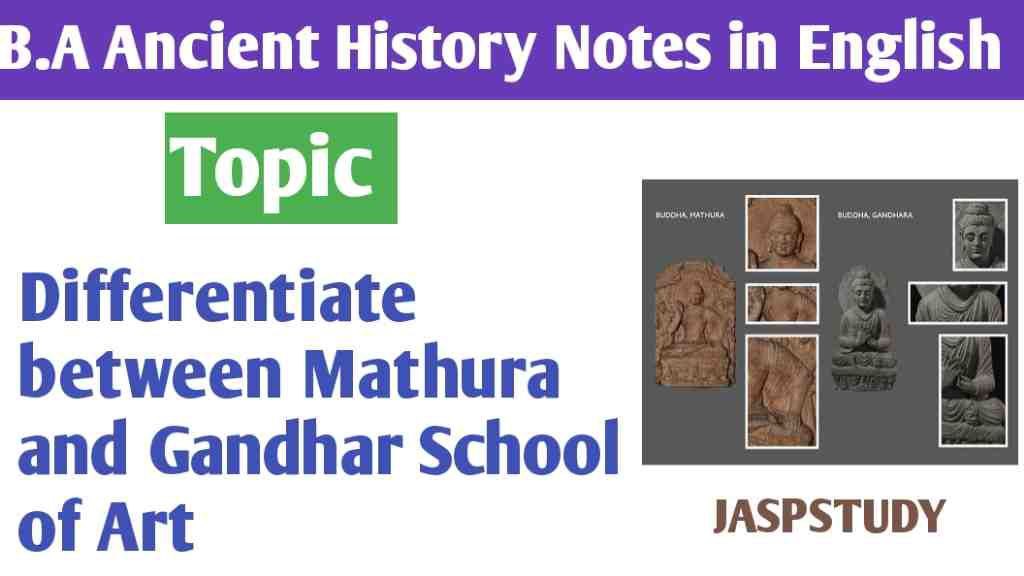In this Article we will Discuss about Difference between Mathura and Gandhar School of Art
Difference between Mathura and Gandhar School of Art
The Mathura and Gandhara schools of art are two important artistic traditions from ancient India, and both played a significant role in shaping the development of Indian sculpture and religious art. Though they were both active around the same time, from the 1st to the 3rd century CE, they had distinct styles, influences, and themes. Let’s explore the differences between the two schools of art in simple terms.
Geographical Location
- Mathura School of Art:
This school originated in Mathura, a city in present-day Uttar Pradesh, India. It was an important center for both Buddhist and Hindu art.
- Gandhara School of Art:
This school developed in the region of Gandhara, which is now parts of modern-day Pakistan and Afghanistan. Gandhara was a crossroads of different cultures and became an important center for Buddhist art.
Cultural Influence
- Mathura School of Art:
The Mathura style was strongly influenced by Indian traditions, with a focus on local culture and religion. It has deep connections with Indian religious beliefs and is seen in both Buddhist and Hindu art.
- Gandhara School of Art:
The Gandhara style was heavily influenced by Greek and Roman art due to the contact with Greek culture during the time of Alexander the Great. This made Gandhara art unique as it combined Greek realism with Indian religious themes, especially Buddhism.

Representation of the Buddha
- Mathura School of Art:
In Mathura art, the Buddha was depicted as a strong, muscular figure. The Buddha’s face had a calm, serene expression, but the body was fuller and robust. This representation showed the Buddha as a human figure with physical strength.
- Gandhara School of Art:
In Gandhara art, the Buddha was shown more realistically and with features similar to Greek gods, with a slender, elegant body. The Buddha’s face often had Greek-style features, like curly hair, a well-defined nose, and a more youthful, serene expression.
- Origin and Geographical Extent of Harappan civilization
- Main features of Mathura Style of kushana Sculptural Art
- Features of the Harappan civilisation
- Sailent features of the town planning of Harappan civilization
- Write a detailed note on Kayatha Culture and its salient features
- Write an essay on Jorwe Culture
- Main Features of Mauryan Art
- Discuss The Philosophy of History of Arnold Toynbee
- Date of coronaion of Kanishka1|Date of Accession of Kanishka 1
Material and Techniques
- Mathura School of Art:
Mathura artists used sandstone, which was abundant in the region. The sculptures from Mathura were often bold and had more solid, strong shapes.
- Gandhara School of Art:
Gandhara artists used grayish stone and schist (a type of soft stone) to carve their sculptures. Their work often had smooth, fine detailing and a more polished finish.
Artistic Style
- Mathura School of Art:
Mathura art is more Indian in style. The figures are often more symbolic and are shown in a powerful, robust manner, reflecting the strength and spiritual focus of the subjects. The art here is closely connected to Indian religious traditions.
- Gandhara School of Art:
Gandhara art is a fusion of Indian and Greco-Roman styles. The figures are depicted with realistic details, and the drapery of clothing is shown in a way that resembles the flowing robes of Greek statues. The artistic style is more refined and naturalistic compared to Mathura art.
Themes and Iconography
- Mathura School of Art:
Mathura art often focuses on Indian religious themes. The Buddha is represented in various poses like meditating or teaching. Hindu deities, such as Vishnu and Shiva, were also depicted in Mathura, with a focus on strength, divinity, and royal power.
- Gandhara School of Art:
Gandhara art focused mainly on Buddhist themes and was more focused on the human side of the Buddha’s life. There are scenes from the Buddha’s life shown in a narrative style, and the art was often designed to teach moral lessons to the people. Gandhara also incorporated Hellenistic (Greek) symbols like the Greek-style drapery and sometimes even Greek gods were included alongside Indian gods.
Facial Features
- Mathura School of Art:
The faces in Mathura art often have a round, calm, and serene expression. The Buddha’s face in this style gives a sense of inner peace, with a focus on spirituality and calmness.
- Gandhara School of Art:
The faces in Gandhara art show a more realistic and Greek-influenced appearance, with features like sharp noses, full lips, and curly hair. The facial expressions are also calm, but they reflect more realism and are often idealized.
Clothing and Drapery
- Mathura School of Art:
In Mathura sculptures, the clothing is often shown with simple folds, which reflect the Indian tradition of draping. The robes of the Buddha or gods are depicted in a way that appears more simple and sacred.
- Gandhara School of Art:
Gandhara artists were known for their elaborate and detailed drapery that often resembled Greek clothing. The robes are shown with deep, flowing folds, similar to the clothing styles seen in Greek statues. The clothing is often shown in a way that reflects Greek artistic tradition but with religious significance.
Emphasis on Realism vs. Symbolism
- Mathura School of Art:
Mathura art is more focused on symbolism, where the figures, such as the Buddha, are depicted with spiritual strength and divine power. The focus is more on expressing religious concepts.
- Gandhara School of Art:
Gandhara art, with its Greek influence, places more emphasis on realism and the human form. The figures are not just symbolic but also portrayed with realistic anatomy and lifelike details.
Conclusion
In summary, the Mathura and Gandhara schools of art are both vital to the history of Indian sculpture, but they have several important differences.Mathura art is rooted in Indian tradition and emphasizes symbolic representation, showing figures with strong, robust forms and a focus on spirituality. Gandhara art, on the other hand, combines Greek realism with Indian religious themes, focusing on realistic details and more naturalistic portrayals of the Buddha and other deities. Both styles reflect the cultural exchanges and religious developments of their time, and they have left lasting influences on Indian and global art.
- Achievements of Kanishka
- Achievement of Pushyamitra Sunga
- Military Campaigns of Samudragupta| Conquest of Samudragupta
- Career and achievements of Julius Caesar|contributions of Julius Caesar
- Intellectual Achievement of Egyptian Civilization
- Salient Features Of Sumerian Civilization
- Salient features of Assyrian Civilization
- Rise of Magadha Empire from Bimbisara to Mahapadmananda
- Achievements of Mahapadmananda
- Salient features of Vedic Culture

